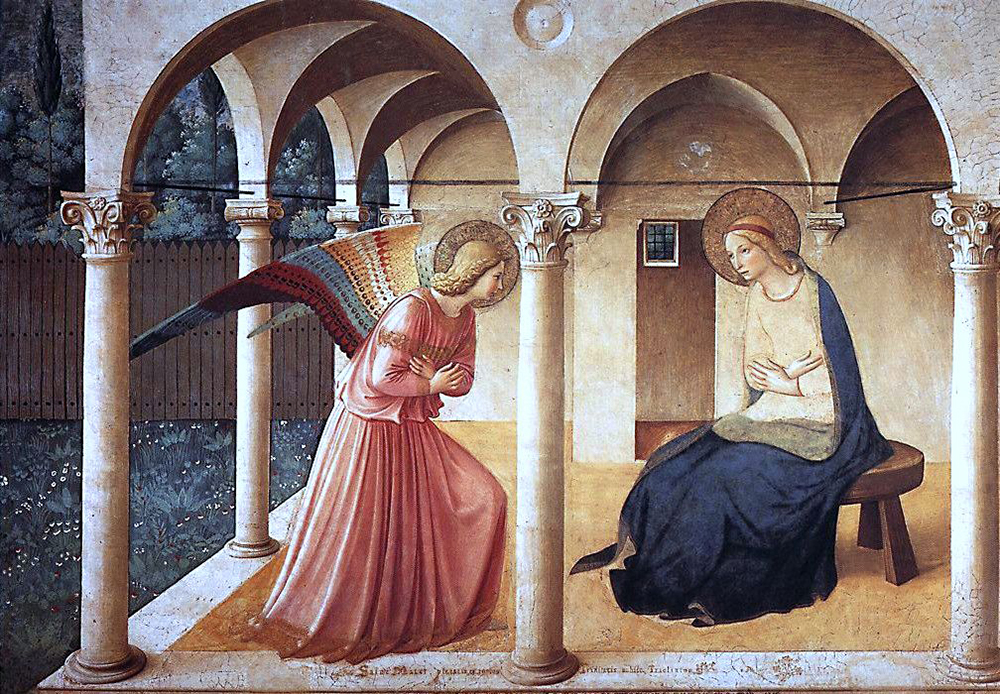As the winds sweep away the last traces of autumn, we gaze upon the flickering flame of a purple candle and turn within ourselves. Advent is a time of bare-hay creches and interior renewal. It is a time not of idle waiting but of zealous preparation. We are called to fashion our souls into dwellings fit for Christ. Perhaps the greatest model for this time is the virgin whose very womb sheltered our savior. Contemplating Mary’s Advent, aided by reflection on a beautiful and inspired classical work of art, can better enable us to receive the Christ child into our own lives.
There is not a great deal written about Mary’s pregnancy, but prayer and art may serve to illuminate that which seems hidden. Matthew and Luke alone offer infancy narratives. The latter gives the most detailed account, even devoting 13 verses to the Annunciation. Many artists — including the 15th century Dominican friar, Fra Angelico — have depicted this most holy occurrence in which the angel Gabriel announced to Mary that she would bring salvation into the world. Fra Angelico’s fresco, painted in the mid-1400s, still commands its wall in the Convent of San Marco in Florence. The spare but magnificently beautiful painting was intended for meditation. Uninhibited by overwhelming symbolism and embellishment, one can be drawn into the simple setting that echoes the architecture of the Florentine cloister. The pillars seem to protrude into the viewer’s space, beckoning one forward to kneel before the haloed figures and become witness to this most significant event. Silent and watchful among virgin and angel, we may come to better know our mother who extends her loving, guiding hand to us during these days of Advent.

Annunciation. Fra Angelico/Public domain
One of the most striking aspects of this painting is Mary’s serenity. Though Luke records her initial apprehension at the sight of the angel, we know that Mary ultimately responds, “Behold, I am the handmaid of the Lord. May it be done to me according to your word” (Lk 1:38). Fra Angelico beautifully conveys her humble fiat through bowed posture and untroubled countenance. This complete surrender to God’s will enabled peace to reign within her. Mary feared nothing because she knew that she had nothing; she had given all to him. Our mother invites us to emulate this surrender, abandoning our egoism and partaking in this meek yielding to the one who created all.
The Lord asks much of every single person. Only our own closed hearts prevent an encounter akin to the Annunciation. A winged messenger may not descend to greet us, and we will not be asked to physically carry redemption within our womb, but God does desire that we become his home. He seeks to dwell in our innermost being. Recall the words of Jesus: “Remain in me, as I remain in you” (Jn 15:4). Our humanity often makes it difficult to discern what form this divine call is to take in our life. We know only that a life in Christ involves much uncertainty, immense trust, and — at times — suffering. It is only natural that our response be marked by fear and hesitation. With the faith of our mother, though, we can respond in a far different manner.
Mary, too, understood the implications of God’s request to her. There would be judgment of her premarital pregnancy, possible scorn from Joseph, and a life of raising the one who would be sacrificed for the sins of the world. She could have run from this seemingly unfathomable task and chosen a quiet, obscure life. Instead, she chose to become a vessel, emptying herself of all that she possessed — including her doubts and angst. Without questions and stipulations, she allowed God to perform the greatest miracle in and through her. The Lord received her fiat and her all, and he gave her peace, a peace that carried throughout her life, even into her most painful Advent — the days of her son’s agony and death. This is what Fra Angelico painted upon the wall of San Marco. Through color and form, he shows us the calm that God bestows upon the ones who answer yes to his summons.
During this season of waiting, we can, through his grace, attain this peace for ourselves. Mary holds the lamp, illuminating the way. There are many ways in which we can turn to her throughout these anticipatory days, such as praying the Rosary (reflecting in particular on the First Joyful Mystery) and the Angelus (which proclaims Mary’s fiat). Another simple and beautiful way to draw closer to our mother and the peace that her son gives is to consecrate each day to her with the following prayer:
My Queen, my mother, I give myself entirely to you,
and to show my devotion to you I consecrate to you this day
my eyes, my ears, my mouth, my heart, my whole being, without reserve.
Wherefore, good mother, as I am your own, keep me and guard me
as your property and possession. Amen.
Receiving our prayer, our mother will purify our hearts throughout each day, enabling us to, as she did, to say yes to the Lord. Saint Augustine wrote, “The world being unworthy to receive the son of God directly from the hands of the Father, he gave his son to Mary for the world to receive him from her.” In doing so, he gave us not only the chance for eternal life, but also the gift of a mother whose fiat shows us the path to her son. During the four weeks of Advent, we can look to her, lean on her and, through his grace, become more like her.




